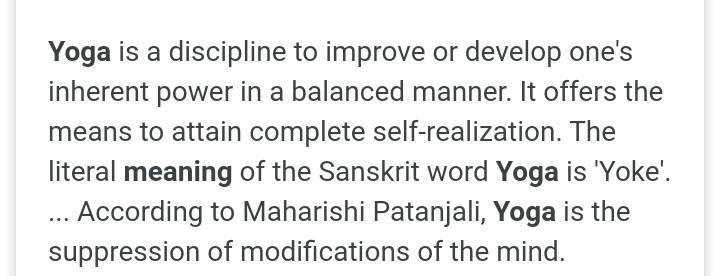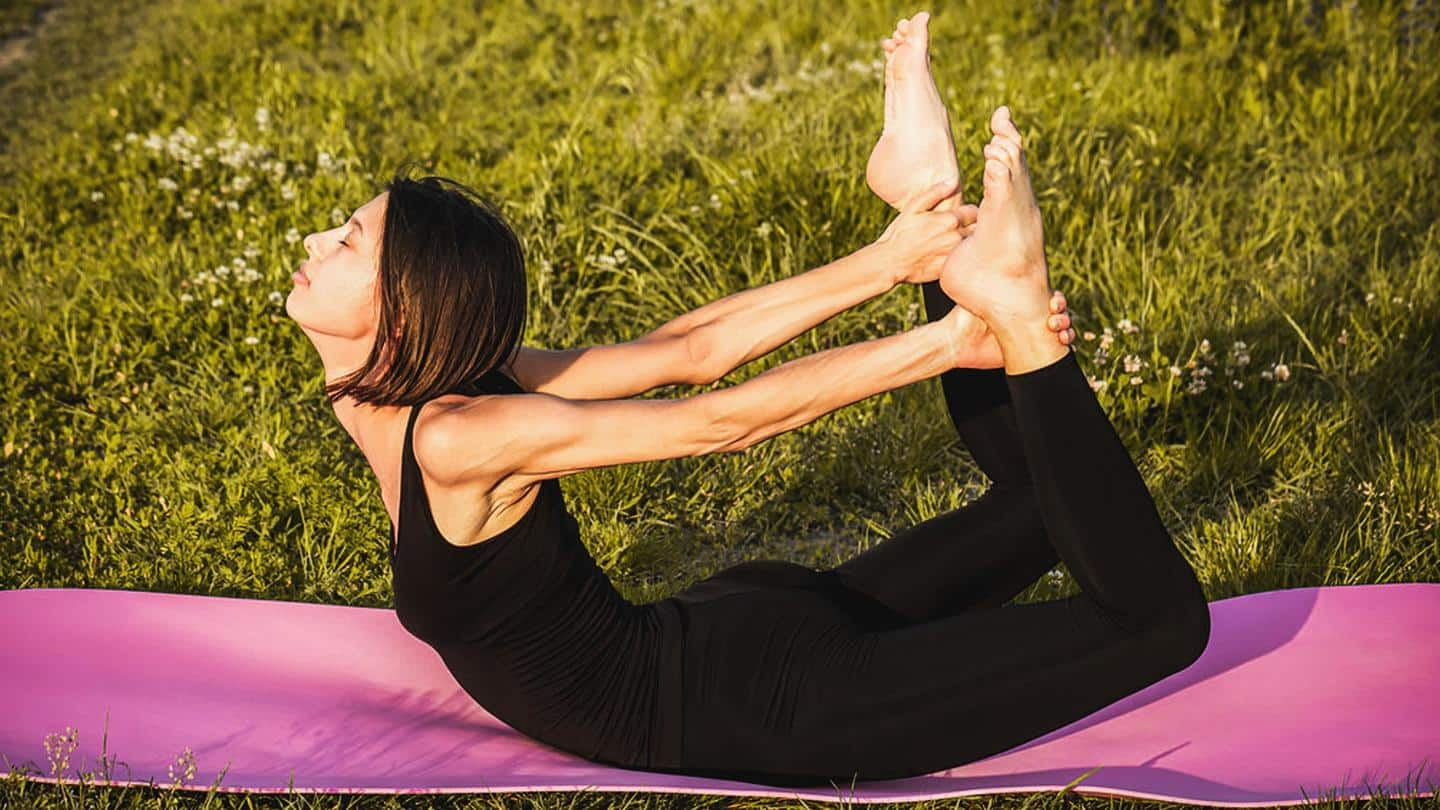
Dandasan is the first of all yogic exercises. With both of your feet in front, sit on the floor. Your hands should be on each side of your waist. The fingers should point in the opposite direction. Repeat the exercise eight to 10 times. Continue the exercise with the third and fourth poses. You can also experiment with a variety of these poses. Some of these can be done in bed. Here are some tips and tricks for performing these exercises.
It doesn't take much equipment to do yoga. A yoga mat and a chair may suffice. To perform these movements, you do not need any special equipment. These exercises can also be done from a chair or on your bed. Some poses can be helpful for women with certain conditions. It's important to check with your health care provider before starting any new exercise routine.

Yoga's main objective is to unite with your spirit. This process is known by moksha. It is the cessation or reduction of all spontaneous activity. This goal is contrary to the Christian's. They are warned to give living sacrifices in order to God's transformation of their minds. Nonetheless, many people do not believe in the possibility of achieving this goal. They seek to attain moksha via meditation.
Yogaic exercises can have many benefits. They improve flexibility and strength. They can also help to relax. They can help you relax and improve your mood. The breathing practices in yoga can alleviate the symptoms of stress. Yogic exercises can be very beneficial for women. But, there are no studies that show they have any harmful effects on the human body. These are merely myths and may not be true.
Many people aren't aware of the benefits of yoga. These practices can be beneficial for many reasons. They increase flexibility and decrease the chance of you developing heart disease. They also increase your stamina and immunity. They can reduce your chance of developing cardiovascular disease. Those are just a few of the benefits of yogic exercises. It is crucial to practice the exercises at least one week. You will see results if you do these yoga poses regularly.

There are many benefits to yoga. It has benefits both for the mental and physical aspects of your health. Studies have shown that yoga enhances our awareness of our bodies and improves our brain function. Yoga can improve our moods and help us to cope with many conditions. Some researchers believe that it can reduce the risks of cardiovascular disease. Some studies have shown that yogic exercises can improve cognition. This can help with impulsive behavior.
FAQ
Which workout is best to build muscle?
You need to perform two types of exercises when building muscle mass. These are isolation exercises and compound moves. Isolation exercises target specific muscles while compound moves focus on multiple groups at once.
You can improve your workouts by choosing exercises that challenge all major muscle groups. This ensures that each session is challenging.
MyFitnessPal is an app that allows you to track your activities. It lets you log everything from calories burned and weight lifting. It also allows you to create meal plans customized for your goals.
What does butter do?
Butter is a great source of saturated fats. This type is beneficial for healthy skin and hair as well as stronger bones.
Butter also contains vitamin K, which prevents bleeding from cuts and bruises. Vitamin K and vitamin C work together to prevent bruising.
Butter also contains minerals like calcium, phosphorous and potassium. These elements are good for teeth and bones.
Butter has its drawbacks. Butter has high cholesterol. Some studies show that consuming too much cholesterol may increase the risk of developing cardiovascular disease.
Also, butter is high in saturated fat, contributing to obesity and increased cholesterol levels.
If you have to have butter, spread it on bread instead of dipping it in soup or salad. Bread absorbs more oil than potatoes or pasta.
What is a good seven-day workout routine?
A seven day exercise program should include cardiovascular training (running or biking), strength exercises (using freeweights, weight machines) and one flexibility/core workout. Each activity should be performed at least once each week. Each session should not last more than 45 minutes.
Cardiovascular Exercise: Running/Biking/Swimming
The goal is to get in at least 60 minutes of cardio activities per week. You can aim for 75 minutes a week for best results. Cardio exercise can improve blood flow and stimulate muscle development.
Strength Training
Cardio exercises focus on the heart and lungs while strength training targets muscles and bones. Strength training increases lean muscle mass and helps to burn calories even at rest.
Flexibility and Core Workouts
You can strengthen your entire body by strengthening flexibility and core exercises. Yoga and Pilates are both excellent choices.
Statistics
- 10 pounds in a month is likely during a lean bulking phase, especially for beginners. (muscleandstrength.com)
- Candidates and applicants must pass all four tests at 70% (minimum level) to graduate from Basic Deputy U.S. Marshal (BDUSM) Training. (usmarshals.gov)
- The PRS enabled risk stratification for overall prostate cancer and lethal disease with a four-fold difference between men in the highest and lowest quartiles (HR, 4.32; 95% confidence interval [CI], 3.16-5.89). (pubmed.ncbi.nlm.nih.gov)
- By John Thompson Take a whopping 38% off a set of PowerBlock Pros. (menshealth.com)
- According to the American Academy of Dermatology (AAD), men over 50 are at a heightened risk of developing it. (healthline.com)
External Links
How To
How do I lose fat by exercising?
Exercise reduces calories by increasing metabolism, and oxygen consumption.
At moderate intensity, you will lose weight easily.
These are the top tips for burning fat while you exercise.
-
Cardio exercises include walking, running, swimming, cycling, running and jogging.
-
Three times per week, exercise for 30 minutes.
-
Add strength training to your workouts if you are looking to lose more weight.
-
Avoid intense exercise. You can build muscle without having to lose muscle tissue.
-
Hydrate well during exercise. Water flushes out toxins, and keeps your body properly hydrated.
-
After working out, drink low-fat protein shakes. Protein shakes are great for your muscles and energy.
-
Take smaller meals throughout each day to avoid feeling hungry.
-
Don't skip breakfast! Skipping breakfast can cause you to feel tired and sluggish.
-
Mental health is important. Stressful situations can affect your metabolism.
-
Keep a positive attitude. Research shows that overweight people gain more weight if they believe they are overweight than those who believe they look good.
-
Sleep enough. Lack of sleep makes it harder to burn fat.
-
Stay active. Get up every hour and get moving.
-
Maintain a healthy diet. You will feel fuller longer if you eat right.
-
Find ways to relax. A tense mind doesn't allow your body to release stress hormones that break down muscle tissue.
A balanced diet provides all the nutrients necessary for growth and development.
Six small meals per day is better than three large meals. This gives your body more time to digest the food you eat.
For strong bones, we need 500 mgs of calcium daily. Calcium is found in dairy products like yogurt, fortified milk beverages, orange juices, cereals and bread.
Calcium is found in leafy green vegetables and beans, tofu as well as nuts, seeds, cheese, and seeds.
Vitamin D is required by the body to absorb calcium. Vitamin D is found in eggs yolk, fatty fish and fortified foods.
Vitamin E plays an important role in skin health. Vitamin E can also be found in vegetable oil, wheat germ oils, peanuts as well almonds, sunflower seeds and corn.
Your body needs zinc to maintain normal immune function and heal wounds. Zinc can also be found in legumes, oysters, meats and whole grains.
Zinc deficiency can cause fatigue and loss of appetite. It can also lead to depression and impaired immunity.
Eating too much sugar causes insulin resistance, which increases blood glucose levels. Insulin resistance causes weight gain.
High levels of free radicals can lead to insulin resistance. Free radicals can be molecules with unpaired electrons that cause damage to cell membranes.
The most common sources of free radicals include food additives.
Free radical damage can lead cancer, heart disease or diabetes, arthritis, asthma, or other forms of aging.
Eating a well-balanced diet with antioxidants is the best way to prevent free radical damage. Antioxidants protect against oxidative damage.
Antioxidant vitamins include Vitamin C (found in citrus fruits), beta carotene (found in carrots, sweet potatoes, spinach, broccoli, cantaloupe, apricots, squash, mangoes, peaches, peppers, tomatoes, cabbage, cauliflower, kale, Brussels sprouts, collard greens, watermelon, and strawberries), and Vitamin E (found in nuts, olive oil, avocados, and eggs).
Other antioxidant nutrients include selenium, copper, manganese, and zinc.
Selenium helps to protect cells against free radicals and oxidative stress. Selenium is also found in Brazil nuts.
Copper protects the brain, eyes, lungs, and red blood cells. Copper is found in shellfishes, poultry, meat, organ meats, and other foods.
Manganese forms an essential part of bone structure. Manganese is found in brown rice, spinach, bananas, prunes, raisins, oatmeal, and lentils.
Zinc is required for normal growth, reproduction and wound healing. Zn is present in lean cuts of meat and white fish, as well as eggs.